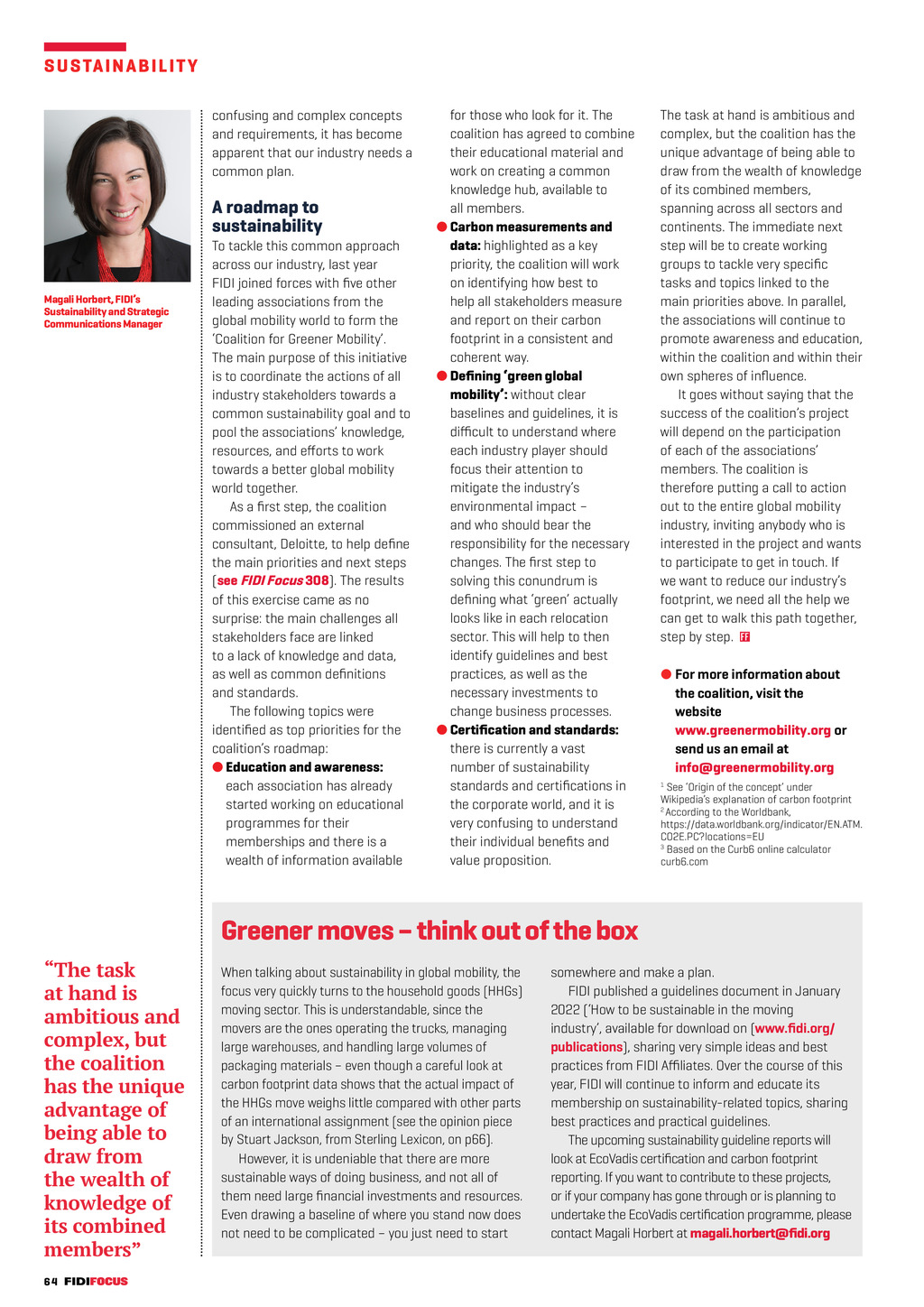




S U STA I N A B I L I T Y confusing and complex concepts and requirements, it has become apparent that our industry needs a common plan. A roadmap to sustainability Magali Horbert, FIDIs Sustainability and Strategic Communications Manager To tackle this common approach across our industry, last year FIDI joined forces with five other leading associations from the global mobility world to form the Coalition for Greener Mobility. The main purpose of this initiative is to coordinate the actions of all industry stakeholders towards a common sustainability goal and to pool the associations knowledge, resources, and efforts to work towards a better global mobility world together. As a first step, the coalition commissioned an external consultant, Deloitte, to help define the main priorities and next steps (see FIDI Focus 308). The results of this exercise came as no surprise: the main challenges all stakeholders face are linked to a lack of knowledge and data, as well as common definitions and standards. The following topics were identified as top priorities for the coalitions roadmap: l Education and awareness: each association has already started working on educational programmes for their memberships and there is a wealth of information available for those who look for it. The coalition has agreed to combine their educational material and work on creating a common knowledge hub, available to all members. l Carbon measurements and data: highlighted as a key priority, the coalition will work on identifying how best to help all stakeholders measure and report on their carbon footprint in a consistent and coherent way. l Defining green global mobility: without clear baselines and guidelines, it is difficult to understand where each industry player should focus their attention to mitigate the industrys environmental impact and who should bear the responsibility for the necessary changes. The first step to solving this conundrum is defining what green actually looks like in each relocation sector. This will help to then identify guidelines and best practices, as well as the necessary investments to change business processes. l Certification and standards: there is currently a vast number of sustainability standards and certifications in the corporate world, and it is very confusing to understand their individual benefits and value proposition. The task at hand is ambitious and complex, but the coalition has the unique advantage of being able to draw from the wealth of knowledge of its combined members, spanning across all sectors and continents. The immediate next step will be to create working groups to tackle very specific tasks and topics linked to the main priorities above. In parallel, the associations will continue to promote awareness and education, within the coalition and within their own spheres of influence. It goes without saying that the success of the coalitions project will depend on the participation of each of the associations members. The coalition is therefore putting a call to action out to the entire global mobility industry, inviting anybody who is interested in the project and wants to participate to get in touch. If we want to reduce our industrys footprint, we need all the help we can get to walk this path together, step by step. l For more information about the coalition, visit the website www.greenermobility.org or send us an email at info@greenermobility.org See Origin of the concept under Wikipedias explanation of carbon footprint According to the Worldbank, https://data.worldbank.org/indicator/EN.ATM. CO2E.PC?locations=EU 3 Based on the Curb6 online calculator curb6.com 1 2 Greener moves think out of the box The task at hand is ambitious and complex, but the coalition has the unique advantage of being able to draw from the wealth of knowledge of its combined members 64 When talking about sustainability in global mobility, the focus very quickly turns to the household goods (HHGs) moving sector. This is understandable, since the movers are the ones operating the trucks, managing large warehouses, and handling large volumes of packaging materials even though a careful look at carbon footprint data shows that the actual impact of the HHGs move weighs little compared with other parts of an international assignment (see the opinion piece by Stuart Jackson, from Sterling Lexicon, on p66). However, it is undeniable that there are more sustainable ways of doing business, and not all of them need large financial investments and resources. Even drawing a baseline of where you stand now does not need to be complicated you just need to start somewhere and make a plan. FIDI published a guidelines document in January 2022 (How to be sustainable in the moving industry, available for download on (www.fidi.org/ publications), sharing very simple ideas and best practices from FIDI Affiliates. Over the course of this year, FIDI will continue to inform and educate its membership on sustainability-related topics, sharing best practices and practical guidelines. The upcoming sustainability guideline reports will look at EcoVadis certification and carbon footprint reporting. If you want to contribute to these projects, or if your company has gone through or is planning to undertake the EcoVadis certification programme, please contact Magali Horbert at magali.horbert@fidi.org